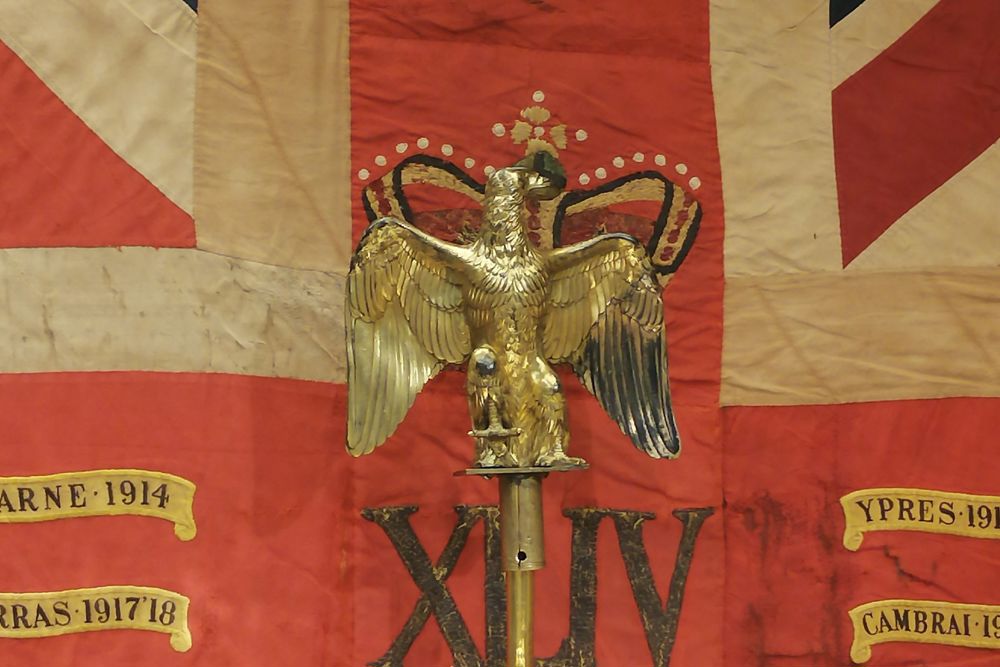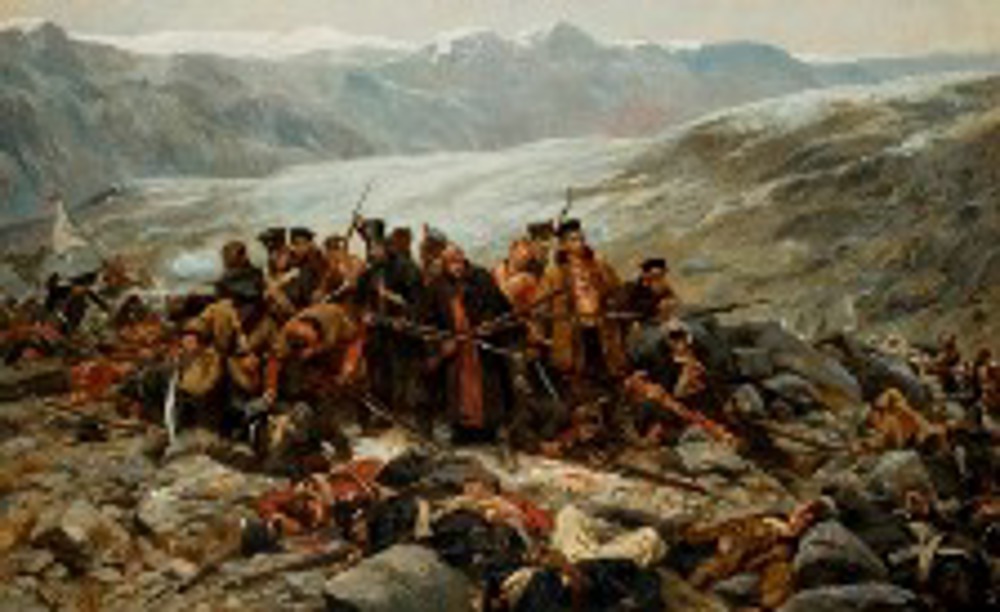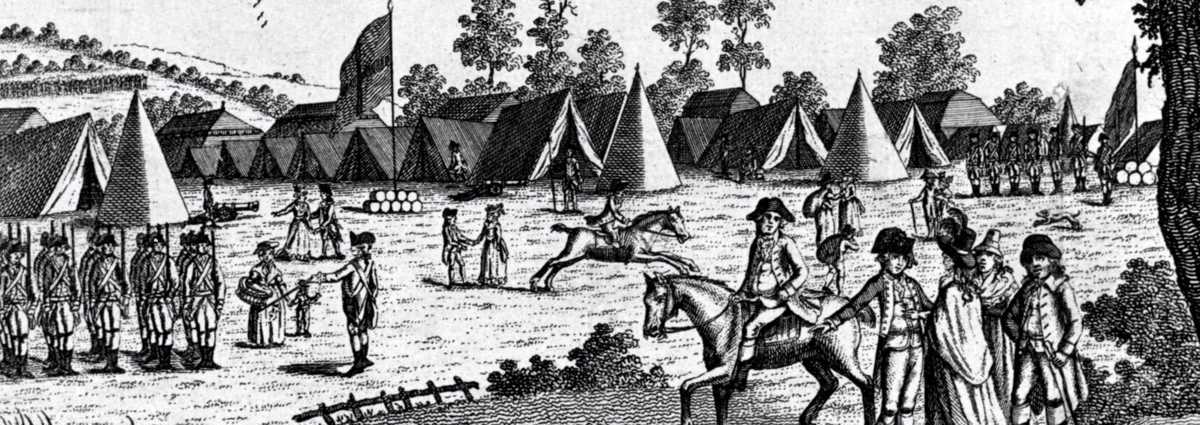Please note: During the Love Parks event on Friday 26 July, parking won’t be available at the museum except for blue badge holders. You can read our list of alternative parking available on our website.
Origins
The rise of England as a world power in the seventeenth and eighteenth centuries meant a gradual expansion of the standing army. In 1741 the 44th Regiment of Foot was one of seven infantry regiments raised during the Austrian Succession.
A few years later, in 1755, with the approach of The Seven Years War, ten additional foot regiments were raised. These included the 56th Regiment of Foot. They were nicknamed the 'Pompadours'. This was adopted the shade known as "Rose-Pompadour" for their facing colour (collar, lapels and cuffs). This was the favourite colour of the Marquise de Pompadour, mistress of King Louis XIV.
Early campaigns
The 44th Foot saw action soon after they were raised at the Battle of Preston Pans in 1745, and in Flanders in 1747.
In 1755 they were sent to North America, where they shared in the tragic march of Braddock's ill-fated column through the American forests, and in the disastrous attack on Fort Ticonderoga and the capture of Niagara. The start of the American War of Independence in 1775, saw the 44th in North America. It fought with courage through the unfortunate campaign.
The 56th saw service at the capture of Havana in Cuba in 1762. The Regiment was awarded the unique battle honour "Moro", in addition to the honour "Havannah" for it's defence of the city. These are the oldest battle honours emblazoned on the Colours of The Essex Regiment.
After a short spell of garrison duty in Ireland, the 56th were sent to Gibraltar where it served for twelve years, including during the Great Siege of Gibraltar (1779-83) against France and Spain who had allied with the American colonists. The Rock was held only by the indomitable courage of its garrison. The Regiment were awarded the battle honour "Gibraltar, 1779-83" with the right to bear its Colour a "Castle and Key" with the motto "Montis Insignia Calpe". Calpe was the ancient name for Gibraltar. This symbol continues to be part of the badge of the Royal Anglian Regiment.
Connection with Essex
In 1782 a system of linking regiments with geographical areas took place. The 44th became the 44th or East Essex Regiment. The 56th, the Pompadours became the West Essex Regiment. This was the first territorial connection of the two regiments with Essex.

Salamanca and the little fighting fours
Expansion of the army during the Napoleonic Wars resulted in the raising of the 2/44th in Ireland. It won for the Regiment the battle honours of "Badajoz", "Salamanca", "Peninsula" and "Waterloo". It was a party of the 2/44th, under command of Lieutenant W. Pearce, that captured the Eagle Standard of the 62nd Regiment of French Infantry during the Battle of Salamanca in 1812. This Eagle (only five were taken in battle in all the wars with the French) rests in the Museum and an Eagle badge is worn as an arm badge by the Royal Anglian Regiment.
The gallantry of the 2/44th gained them the nickname 'The Little Fighting Fours'.
After Napoleonic France was defeated in 1815, there was an era of peace. This lasted until the Crimean War in 1854. The regular army, however, saw much service in small wars of colonial expansion. The 44th served in Ireland, India, Assam and Burma, Afghanistan, Gibraltar and Malta. It was awarded the battle honour "Ava" for its part in the expedition that occupied the Arakan and Assam in 1824.

Afghanistan
In 1841 the Regiment was sent to Kabul, Afghanistan, which was occupied by the British. Violent insurrection placed the British garrison in jeopardy. It attempted to retire on Jellalabad. Incessantly attacked, without shelter or food, the force waded in deep snow through the narrow passes for four days, at the end of which the entire column had been annihilated. A last stand was made by twenty men of the 44th at Gundamuck.
During the final stage of the retreat, Lieutenant T.A Souter tore the Regimental Colour from its pike and tried to hide it by wrapping it round his body. In the final massacre, his life was spared - the Afghans, seeing the rich material of the Colour, took him for a person of high birth and rank. Lieutenant Souter and the Colour eventually returned unharmed, but the Queen's Colour was lost. Remnants of the Gundamuck Colour hang in the Regimental Chapel at Warley.
Crimea and China: The first Victoria crosses
In 1854 both Regiments served in the Crimean War. The 44th Regiment was awarded the battle honours "Alma" and "Inkerman". Both the 44th and 56th were awarded "Sevastopol", having participated in the siege. Stirred by the gallantry of her troops in this war, Queen Victoria instituted the award of the Victoria Cross. One of the very first was awarded to Sergeant W.McWhiney of the 44th.
The end of the Crimean War was quickly followed by the Indian Mutiny (1857). Both 44th and 56th were dispatched as reinforcing units. They arrived too late, however, to take any part in that arduous campaign. But four years later, the 44th was again to see active service. This was at the storming of Taku Forts in North China. Lieutenant R.M. Rogers and Private J. McDougal were both awarded the Victoria Cross for valour in this action.
The Essex Regiment
In 1881 important changes known as the Cardwell Reforms were made. The various infantry units of a county or district were grouped territorially. In Essex, the 44th (East Essex) Regiment and the 56th (West Essex) Regiment were brought together and called the 1st and 2nd Battalions of The Essex Regiment.
The two units of the ancient militia, the East Essex Militia and the Essex (Rifles) Militia, were re-designated the 3rd and 4th (Militia) Battalions of The Essex Regiment. The depot companies of these four units were brought together at Warley Barracks and formed into the Regimental Depot. Finally the various Corps of Essex Rifle Volunteers became the four Volunteer Battalions of the Regiment. In this manner was the foundation laid for the Territorial Army.
Under the Cardwell system it was intended that one regular battalion should be at home while the other served abroad. So we find the 1st Essex at home from 1880, and the "Pompadours" serving in Gibraltar, Malta, Egypt and the Sudan, Cyprus, India and Burma. In 1884 they formed part of the River Column under Lord Wolseley, which struggled up the Nile to relieve Khartoum and save General Gordon from the Mahdi, who had overrun the Sudan. For this campaign the Regiment was awarded the battle honour "Nile, 1884-5".
The Boer War
Both regular Battalions, the 3rd (Militia) Battalion and elements of the Volunteer Battalions, served in the South African War (1899-1902), the Regiment gaining the battle honour "South Africa, 1899-1902", while the 1st Battalion was awarded in addition the honours "Relief of Kimberley" and "Paardeberg" for its part in those engagements. At Paardeberg, Lieutenant F.N. Parsons gained the fourth Victoria Cross to be awarded to the Regiment.

